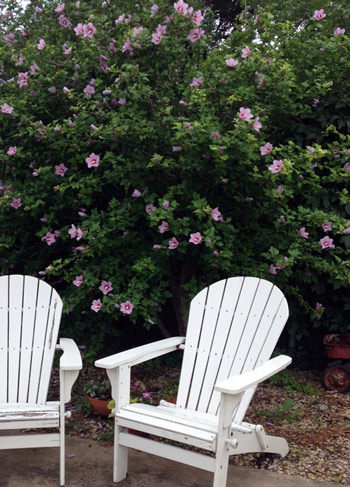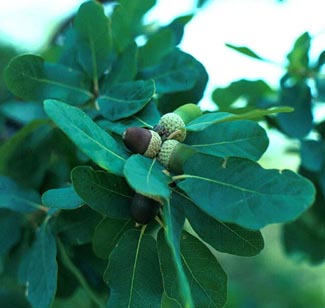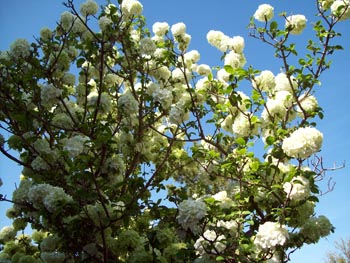Central Texas Trees
Perhaps the most important facts you must know to be successful with trees in Central Texas is what trees do the best here, and when and how to plant them. Whenever possible, plant trees in the very late fall or winter. This will help your tree develop roots and get established before it has to face a Texas summer. Never plant a tree when it is hot and dry. You can plant in the Spring, but this is a poor third choice.
How to plant: Dig a hole where you
want the tree, making sure that you have met the light requirements of your
particular tree. Try to keep in mind that the little twig you are planting will
get really big, so allow plenty of room for it as it grows. Don't plant a tree where it will shade your vegetable garden or fall over and crush your roof during a storm. Keep your neighbors in mind when you plant near their property borders.
Now, back to that hole you dug. Fill the hole with a bucket of water and go away. Come back in an hour and see if the water is gone, or almost gone. If it is gone you may proceed. If not, come back in two hours and see if it has drained away. If it has not, you may have to plant your tree in another location or in a raised bed. Trees need adequate drainage. Consult a Master Gardener or tree expert about other, more complicated ways to provide drainage, if you must have it in that location.
Once you are ready to plant, make sure that the edges of the hole are not slick. Break them up with your shovel. You don't want to form a pot made from your hole that will fill with water and drown your plant. Once you are ready to plant, take the tree out of its nursery pot or unwrap it and set the roots in a big bucket of water. Leave the tree there until it is saturated.
Remove the tree from the water bucket and examine the root ball. The top of the tree roots where they just begin to flare out from the trunk, should not be covered with soil. If they are, carefully remove soil from around this area. You can use a water hose to do this. Notice if the tree has roots which encircle the trunk. This is very bad! Remove any such roots with a knife or clippers, or gently unwind from around the trunk. If you don't do this, your tree may die eventually.
Now set your tree in the hole and add a little native soil if needed to bring it level so that the root flair is sitting just above the surface of the soil. Do not use amended soil! Fill the hole only with soil you dug out of the hole. This will prevent the hole from becoming a water pot when it rains. If you are planting something like Azaleas, and we hope you aren't, then you must dig up a big bed that is many feet wider than your trees or shrubs and then plant in that bed. Then it is all right to amend the soil.
After you have filled the soil in, water the tree. This will settle the soil and you may find that you will need to add a little more soil on top. Whatever you do, don't step on the soil with your foot to tamp it down!!!! You will probably not need to brace the tree with stakes and wires, this weakens trees and creates problems later on. Never wrap the trunk with paper; that is just sheer ignorance. Don't paint the tree after trimming; it doesn't help.
For serious problems on big trees like oaks, you will need to consult an arborist; these are complicated and require the advice of an expert trained in this field--not someone passing by your house who trims trees on the side. Big trees can be very dangerous for yourself and your property if trimming is handled by a novice.
We do not like to plant very big trees close to houses; there are just too many problems with the destructive roots and heavy branches. If you have the choice, don't plant large trees that will grow huge trunks next to your house. Remember that the tree you plant 10 feet from your house will easily extend right over your roof in time. Big trees need big property to grow on.
Best Trees for Central Texas:

 Althea: Also known as the Rose of Sharon, this wonderful flowering small tree is a joy to possess.
It can take full sun and does not need a lot of water. This is one of my very favorite trees.
Photo to the left.
Althea: Also known as the Rose of Sharon, this wonderful flowering small tree is a joy to possess.
It can take full sun and does not need a lot of water. This is one of my very favorite trees.
Photo to the left. Oaks: Oaks are well loved trees, but there can be some serious maintenance and
other problems with them.
Planting them in the right space, and choosing a good variety for our area are essential. Do not put
a huge oak so close to your house that it becomes a big maintenance problem,
constantly having to be trimmed away from the roof. The varieties that we
recommend are Bur oak (Earth-Kind), Shumard oak, Live oak, and Lacey Oak
(Earth-Kind and Texas Superstar and pictured at left). Avoid pruning oaks from February to June to prevent the spread of the disease Oak Wilt, which is a devastating, deadly disease
that is hard to cure.
Oaks: Oaks are well loved trees, but there can be some serious maintenance and
other problems with them.
Planting them in the right space, and choosing a good variety for our area are essential. Do not put
a huge oak so close to your house that it becomes a big maintenance problem,
constantly having to be trimmed away from the roof. The varieties that we
recommend are Bur oak (Earth-Kind), Shumard oak, Live oak, and Lacey Oak
(Earth-Kind and Texas Superstar and pictured at left). Avoid pruning oaks from February to June to prevent the spread of the disease Oak Wilt, which is a devastating, deadly disease
that is hard to cure. Snowball viburnum: if you want a small tree that reaches to 12 feet tall with gigantic white
clusters of blooms this is the plant for you. It blooms mid spring. For the largest cluster of blooms pick the
variety Viburnum macrocephalum, as smaller blooming viburnums also exist. Photo
to the left.
Snowball viburnum: if you want a small tree that reaches to 12 feet tall with gigantic white
clusters of blooms this is the plant for you. It blooms mid spring. For the largest cluster of blooms pick the
variety Viburnum macrocephalum, as smaller blooming viburnums also exist. Photo
to the left.